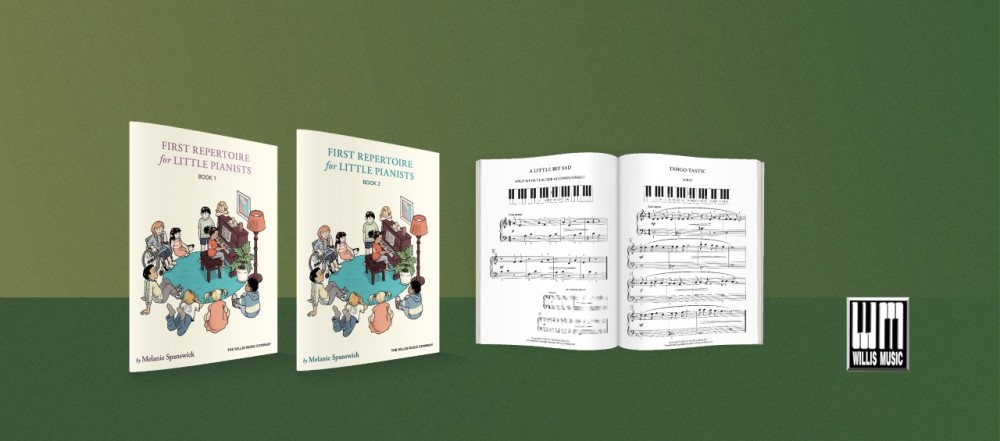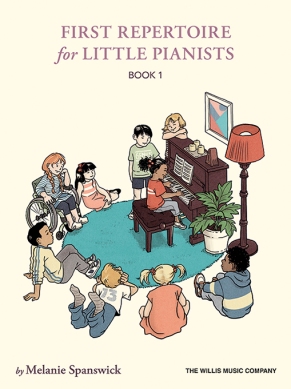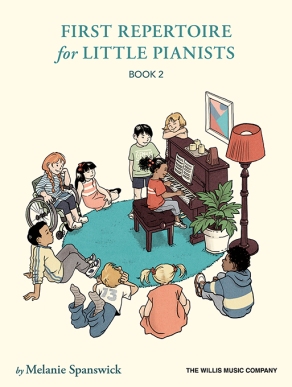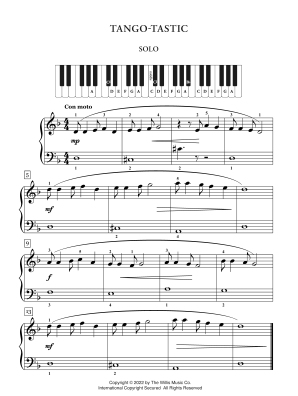
I first started teaching the piano at the age of fifteen – far too young, many would say, and they’d be right! But, encouraged by my teacher, who ran a piano school, I often taught the school’s younger students, and I was always interested to discover various beginners’ methods. My first teacher used her own method, but once established as a teacher on my own, I explored copious adult and child piano method or tutor books.
John Thompson’s Easiest Piano Course was a favourite. One must remember that this all happened years ago, before the introduction of many current popular piano method books. However, over the years, despite the appearance of a whole smorgasbord of newer tutor books, I still like the old-fashioned simplicity of the older courses.
John Thompson’s Easiest Piano Course is published by the world renowned US music publisher, the Willis Music Company. Willis (who now publish in conjunction with Hal Leonard) also publish Edna Mae Burnham’s ever popular A Dozen A Day Series, as well as composer William Gillock’s entire educational piano music catalogue. Other noted composers published by Willis include Glenda Austin, Carolyn Miller, Wendy Stevens and Naoko Ikeda. Against this impressive backdrop, I was really delighted to be invited to write a new piano series for Willis, and I’m the first female British composer to do so.
As most teachers will know, there are numerous beginners’ piano methods on the market today; I recently counted at least 100, many of which we examined on my piano teachers’ course at Chetham’s International Piano Summer School last year. However, something I noticed when I taught beginners, is the relatively scant repertoire available for this important demographic of students and I wanted to create a series for the beginner, and specifically the very young beginner, so that they are able to play other pieces alongside those in their method books.
First Repertoire For Little Pianists is a two-book series featuring fifty very elementary piano pieces. Written during lockdown last year, each book consists of twenty-five original pieces. The books are intended to go hand-in-hand with beginners’ methods, and I believe it’s possible to start using them from the first term of lessons.
Many of the pieces contain a piano teacher accompaniment, so that young students can enjoy performing securely in the knowledge that they won’t be alone at the piano. There are also a selection of ‘solo’ pieces, too. Each piece has a page of practice ‘tips’ complete with fun games and activities.
Two aspects of learning to play the piano which often cause issues for young students are reading notation and ‘feeling’ the rhythmic pulse. These elements have been addressed quite specifically in both books. Plenty of ‘rhythmic’ focus exercises run through the books, involving ‘tapping’ and clapping for the student. ‘Note’ focuses feature throughout, too, often inviting students to write notes and note patterns, as a means to assimilating them efficiently.
Each piece is pre-faced with a diagram of the keyboard with the notes within the particular piece highlighted, illustrating where the notes in the piece ‘live’.

Book 1 showcases very short pieces, often just 8 bars in length, and the journey begins hands separately, gradually incorporating hands playing together. As this music is intended for young children, hands generally stay in five-finger positions in this book, with no wide intervals or stretches. The time signatures 2/4, ¾, and 4/4 are used, as are C major/A minor, G major and F major as well as some pentatonic pieces.

Dynamics, phrase markings, tempo markings, pedalling and fingering have been added, and there are also a few rote pieces, to encourage students to move around the instrument. I’ve also ensured that black keys are used from the outset.

This series is progressive and, therefore, Book 2 is a little more difficult than Book 1. However, every piece is still very short from 8 – 17 bars in length, and the music starts to move out of the five-finger position; I’ve also ensured that all five fingers are called into play in both volumes, as whilst using one or two fingers is often a good idea at the very beginning (there are several works in Book 1 which demand use of just the second or third finger), as students make progress, they must become accustomed to using all five. Tonally, there are more adventurous pieces in Book 2, as well as the use of C, G, and F major, and A, E, and D minor.

Many of the pieces contain illustrations, which I hope children will enjoy (and they are encouraged to ‘colour in’ these drawings), and there are imaginative titles, of which the character is usually mimicked in the music, paving the way for lots of discussion.
I’ve recorded a selection of pieces from each book, and you can hear them by clicking on the links below. The duets are played here with my student, Becky Flisher.
You can find out more and purchase the books by clicking on the links below:
First Repertoire For Little Pianists Book 1
First Repertoire For Little Pianists Book 2
Images Courtesy of The Willis Music Co. No part of this publication may be reproduced in any form or by any means without the prior written permission of the Publisher.
My publications:
For much more information about how to practice piano repertoire, take a look at my piano course, Play it again: PIANO (published by Schott Music). Covering a huge array of styles and genres, the course features a large collection of progressive, graded piano repertoire from approximately Grade 1 to advanced diploma level, with copious practice tips for every piece. A convenient and beneficial course for students of any age, with or without a teacher, and it can also be used alongside piano examination syllabuses too.
You can find out more about my other piano publications and compositions here.
from Melanie Spanswick https://melaniespanswick.com/2022/02/27/first-repertoire-for-little-pianists/
No comments:
Post a Comment